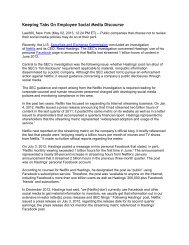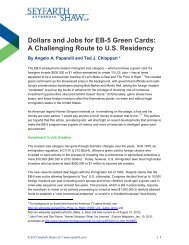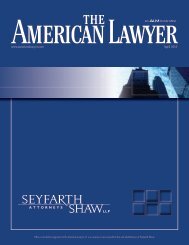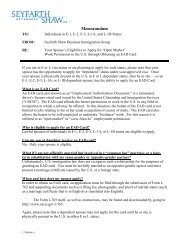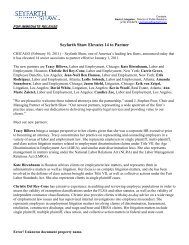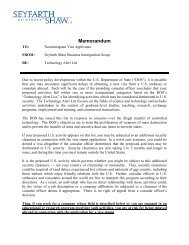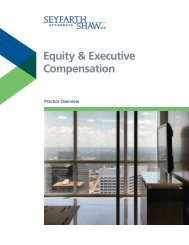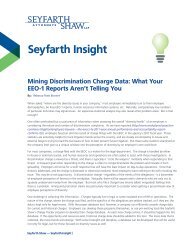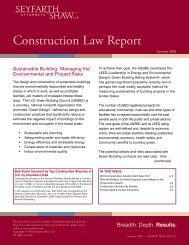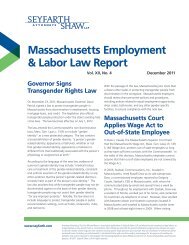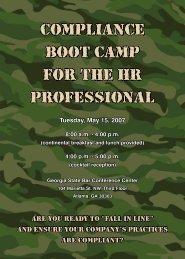Litigating California Wage & Hour and Labor Code Class Actions
Litigating California Wage & Hour and Labor Code Class Actions
Litigating California Wage & Hour and Labor Code Class Actions
You also want an ePaper? Increase the reach of your titles
YUMPU automatically turns print PDFs into web optimized ePapers that Google loves.
Bell court to look beyond the <strong>Wage</strong> Order’s language. In contrast, <strong>Wage</strong> Order 4-<br />
2001 (the current <strong>and</strong> operative <strong>Wage</strong> Order in Harris) incorporates specific federal<br />
regulations <strong>and</strong> contains “detailed guidance” concerning the administrative<br />
exemption. The Court of Appeal in Harris erred by focusing too heavily on the<br />
administrative/production dichotomy rather than applying the language of the relevant<br />
wage order <strong>and</strong> regulations.<br />
The Supreme Court ultimately declined to adopt a rule precluding the use of the<br />
dichotomy as an analytical tool. Instead, the Court held that, in determining whether<br />
work is administrative, courts must consider the particular facts <strong>and</strong> apply the<br />
language of the statutes <strong>and</strong> wage orders at issue. If the statutes <strong>and</strong> wage orders<br />
fail to provide adequate guidance, the Court held, then it would be appropriate to<br />
consider other sources, including, presumably, the administrative/production<br />
dichotomy.<br />
The only concrete guidance from the <strong>California</strong> Supreme Court in Harris is that the<br />
administrative/production dichotomy is not a dispositive test for the administrative<br />
exemption. The Court left open the possibility that the dichotomy may still apply in<br />
future cases. Employers who were looking for more specific guidance from the Court<br />
on the administrative exemption will be disappointed, as, even after Harris,<br />
determining whether an employee satisfies the administrative exemption remains a<br />
highly fact-specific venture.<br />
D. The Outside Sales Exemption<br />
The outside sales exemption is the broadest of all in that it exempts the employees from all<br />
provisions in the <strong>Wage</strong> Orders, even minimum wage protections. 49 To qualify as an outside<br />
salesperson, an employee must “customarily <strong>and</strong> regularly work more than half the working<br />
time away from the employer’s place of business selling tangible or intangible items or<br />
obtaining orders or contracts for products, services or use of facilities.” 50 This definition is<br />
slightly different from the definition of an outside salesperson under the FLSA, which<br />
provides that to be an outside salesperson, an employee must (1) customarily <strong>and</strong> regularly<br />
be engaged away from the employer’s place of business making sales or obtaining orders<br />
or contracts; <strong>and</strong> (2) must spend no more than 20 percent of the work time on other nonexempt<br />
tasks unless the tasks are incidental or in conjunction with the employee’s outside<br />
sales or solicitations.<br />
49<br />
50<br />
IWC <strong>Wage</strong> Order 1-2001(1)(c) (“the provisions of this wage order shall not apply to outside salespersons”). By<br />
contrast, the white collar exemptions exempt employees only from Section 3 through 12 of the <strong>Wage</strong> Orders <strong>and</strong> other<br />
exemptions exempt employees only from Section 3 (governing hours of work).<br />
IWC <strong>Wage</strong> Order 1-2001(2)(j) (defining “outside salesperson”).<br />
Seyfarth Shaw LLP | www.seyfarth.com <strong>Litigating</strong> <strong>California</strong> <strong>Wage</strong> & <strong>Hour</strong> <strong>Class</strong> <strong>Actions</strong> (12th Edition) 15



